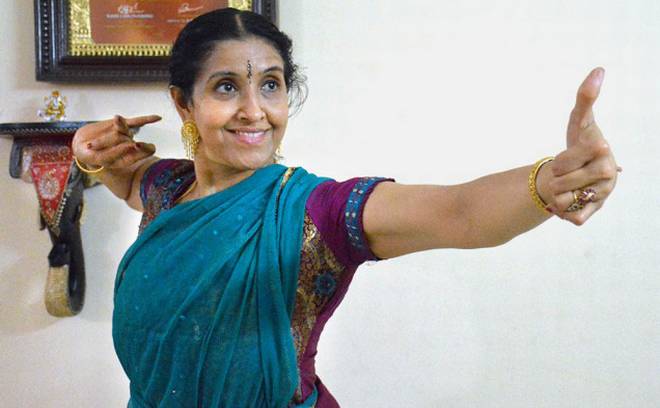New York: Renowned Bharatanatyam exponent and scholar Bala Devi Chandrashekar, who recently performed her latest production ‘Brihadeeswara – form to formless‘ in the city, has said that her productions have universal messages culled out from India’s epics that do not require any language.
Chandrashekar was speaking before the premiere at the leading performing arts center Symphony Space at Broadway last week. She presented her production through the eyes of an ancient Indian Temple dancer – Devaradiyal. It is a story based on the Brihadeeswara Temple in Thanjavur, Tamil Nadu.
The temple, a UNESCO world heritage site, is an architectural marvel, historically significant and dedicated to Lord Shiva.
“When your message is universal, you don’t have to be worried whether the culture is coming from the Asian continent or from Europe or the Middle East,” she told PTI in an interview ahead of her performance.
“It is a very common language especially when it is demonstrated through dance. It is visually very rich, somebody who cannot understand Sanskrit, Tamil or Carnatic music or Hindustani classical music, the art form is visually so effective and vivid that they don’t need to know any language,” she said.
The 90-minute production celebrates the intertwining of the spatial and spiritual vibrations experienced by the temple dancer as she goes about her day to day life in the hallowed architectural wonder of the unique 1000-year-old heritage site and one of the largest South Indian temples.
She has performed ‘Brihadeeswara‘ at the UNESCO headquarters in Paris before a worldwide audience and has taken the production across the globe, including the Netherlands, Germany, Spain, Dubai and Singapore.
Underscoring the important role played by art and dance in bringing diverse cultures together, Chandrashekar said the “whole world is looking for something where we can connect and in today’s time when there are so many differences, through art I would like to be a strong power of India for culture and take this dance form and its message across the world.”
Bharatanatyam has a universal language, she said, adding that any one from across the world can enjoy and understand the dance form if they have an open mind.
“You don’t have to restrict it saying this is only for Indians or only for people who know Sanskrit. It’s meant for everybody. I have taken this to several nations, I’ve never found that I have not been able to connect with them through dance.”
The concept, research and choreography for the production has been done by Chandrashekar, with music composed by Rajkumar Bharathi and the show scripted by P R Venkatasubramanian.
Chandrashekar is known for her in-depth understanding of the 108 ‘Karanas’ or ancient temple sculptures and of the ‘Natya Shastra’, the oldest treatise on dance written around 200 BC.
The dance production, divided into four acts, celebrates the Devaradiyal’s beauty and the architectural mastery of the temple while tracing her day-to-day life oscillating between the spectacular form of the temple and the enlightened awareness of Lord Shiva’s formlessness as the cosmic dancer.
It weaves the connection between the physical, metaphysical, lyrical and spiritual significance of each facet of the magnificent structure through the eyes of the untarnished pure celestial love of the Devaradiyal and the ultimate unification of the individual soul with the supreme energy.
As the composition flows, it touches upon the temple as a metaphor by highlighting the Thirumurai hymns of ‘Sundarar’ and ‘Thirugnana Sambandhar’ in praise of Lord Shiva. Initiated by Goddess Uma, the different dance forms are conceived as performed by Lord Shiva.
PTI
